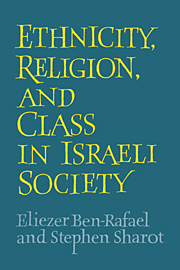Book contents
- Frontmatter
- Contents
- Acknowledgments
- I Theoretical and empirical background
- II Social patterns and behavior
- III Identities and images
- IV The impact of stratification
- V Social cleavages: an overview of Israeli society and some theoretical implications
- 14 Cleavages among Jews
- 15 Jews and Arabs
- 16 Toward a theory of social cleavages
- Appendix A The sample
- Appendix B Deprivation index
- Appendix C Indexes of ethnic identification
- Glossary
- Notes
- References
- Index
15 - Jews and Arabs
Published online by Cambridge University Press: 12 September 2009
- Frontmatter
- Contents
- Acknowledgments
- I Theoretical and empirical background
- II Social patterns and behavior
- III Identities and images
- IV The impact of stratification
- V Social cleavages: an overview of Israeli society and some theoretical implications
- 14 Cleavages among Jews
- 15 Jews and Arabs
- 16 Toward a theory of social cleavages
- Appendix A The sample
- Appendix B Deprivation index
- Appendix C Indexes of ethnic identification
- Glossary
- Notes
- References
- Index
Summary
At the beginning of this study we distinguished between non-national forms of ethnicity, such as among Israeli-Jewish groups of origin, and ethnonationalism. It is the latter term that best denotes the cases of Jewish citizens and Arab or Palestinian citizens of Israel, and of Israeli Jews and the Palestinians in the West Bank and the Gaza Strip. The intra-Jewish cleavages and the Jewish-Arab cleavages differ in fundamental respects, but the framework of dimensions and perspectives in the sociology of ethnicity, discussed in the first chapter, can be applied to both. It is, in fact, the common conceptual framework that allows us to demonstrate the important differences between the two ethnic encounters and the relationships between them.
On the eve of the establishment of the State of Israel the Arab population of Palestine was about 1,200,000, nearly twice as large as the Jewish population. Only 156,000 remained after the first Israeli-Arab war, although there was some increase in the early fifties as a consequence of minor borderline changes with Jordan and a family unification policy. A high natural growth has gradually increased the proportion of Arabs in the population, and today the Arab citizens of Israel constitute 18% of the total population. They are themselves divided by ethnicity and religion: Sunni Muslims are the majority, the Christians belong to a number of churches, the Druze are an important group, and there are smaller groups of Samaritans and Karaites.
- Type
- Chapter
- Information
- Ethnicity, Religion and Class in Israeli Society , pp. 232 - 242Publisher: Cambridge University PressPrint publication year: 1991

